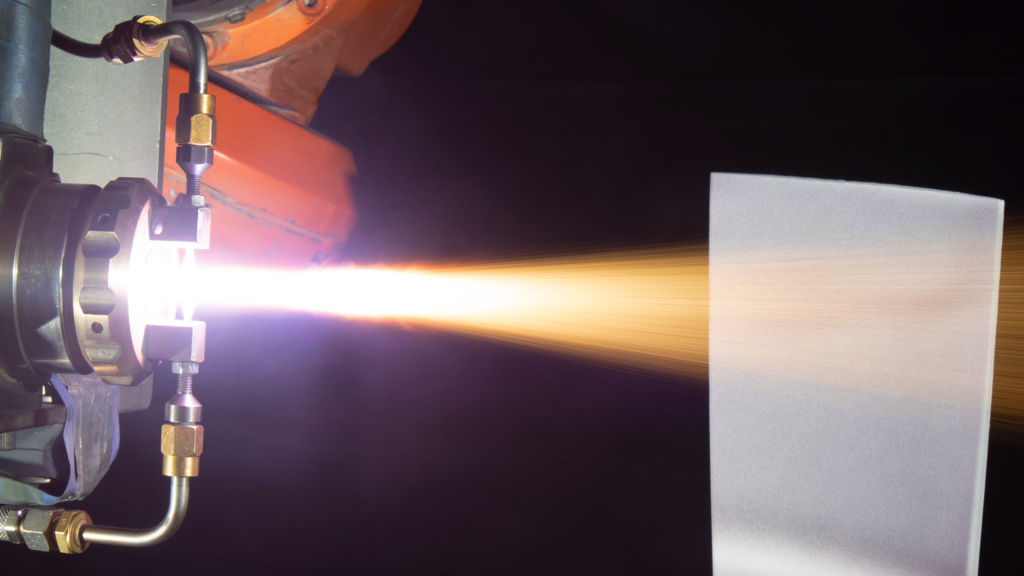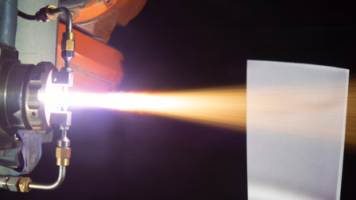The atmospheric plasma spray process is used for wear and corrosion protection, thermal insulation, repair, restoration and further surface functions. As it is the most flexible of all thermal spray processes, coatings can be applied at high deposition rates onto different metallic substrates by using the widest variety of powder feedstock materials composed of metals, alloys, carbides, ceramics and others. As such, atmospheric plasma spray is often used to apply coatings for thermal protection, wear resistance, corrosion control, dimensional control and restoration and much, much more.
Atmospheric plasma spray - a cutting-edge technique
Atmospheric plasma spray (APS) is a cutting-edge materials processing technique that utilizes a high-temperature plasma to produce high-quality coatings on a variety of substrates. This technique involves the injection of fine particles of a material, such as metals, ceramics, or polymers, into a plasma stream generated by the ionization of a gas, typically argon, through an electric arc or radio frequency discharge. The plasma stream melts and accelerates the particles towards the substrate, where they solidify and form a dense, uniform coating.
The atmospheric plasma spray process offers numerous advantages over other coating techniques. It can produce coatings that are highly resistant to wear, corrosion, and thermal stress, and can withstand extreme temperatures and harsh environments. The coatings produced by atmospheric plasma spray are highly adherent to the substrate and have a uniform, fine-grained microstructure, which gives them exceptional mechanical properties. This makes them ideal for use in a wide range of applications, including aerospace, automotive, and energy industries.
Key benefits of with atmospheric plasma spray
One of the key benefits of atmospheric plasma spray is its versatility. It can be used to deposit a wide range of materials, from metals and ceramics to polymers and composites, onto a variety of substrates, including metals, ceramics, and polymers. The coatings produced by atmospheric plasma spray are highly customizable, and their properties can be tailored to meet specific requirements. Other benefits include:
- Most flexible of all the thermal spray processes, with sufficient energy to melt any material — even materials with high melting points such as ceramics.
- Excellent control of coating thickness and surface characteristics such as porosity and hardness
- Widely used for high-volume production
Typical applications
- Gas turbine components
- Textile and printing machinery
- Automotive cylinder liners
- Medical implants
Atmospheric plasma spray process description
A strong electric arc is generated between a positively charged pole (anode) and a negatively charged pole (cathode). This ionizes the flowing process gasses into the plasma state. The powder feedstock material is injected into the plasma jet, melting the powder particles and propelling them onto the workpiece surface.
In addition to conventional atmospheric plasma spray guns, Oerlikon Metco has pioneered cascading arc plasma spray guns. Cascading arc spray guns constrain the arc between the anode and cathode, resulting in a more controlled spray plume. In turn, this results in more homogeneous heating of the plasma particles, and significantly increases the possible spray throughput (measured as deposit efficiency times spray rate). The resulting coatings are more reliable and can be applied faster.
Atmospheric plasma spray process basics
- Heat source: arc
- Feedstock: powder (ceramics, metals, alloys, blends, carbides and others)
- Plasma temperature: approx. 16 000 °C (28 800 °F)
- Particle velocity: up to 450 m/s (1 500 ft/s)
- Approximate application rate: 4 to 8 kg/h (9 to 18 lb/h)
Overall, atmospheric plasma spray is a highly advanced and versatile technique that offers a wide range of benefits for industrial applications. Its ability to produce high-quality coatings with exceptional mechanical and physical properties has made it a popular choice for a variety of industries, and it continues to be a key area of research and development in the field of materials science.




